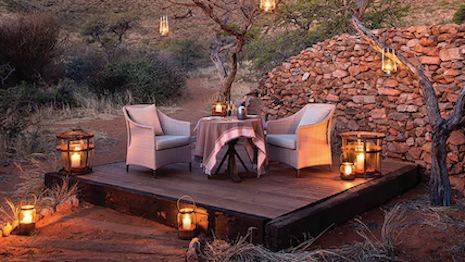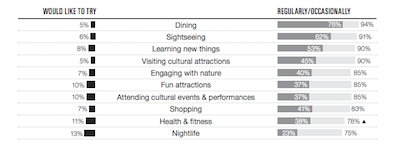 Private dining at Tarkuni Safari Camp, South Africa
Private dining at Tarkuni Safari Camp, South Africa
The luxury travel industry still yields high results with affluent consumes going on more than triple the number of trips average households take, according to a report prepared by Resonance.
General consumers in the United States take only an average of 4.8 trips a year, compared to the wealthiest 5 percent who take more than 14.3 trips per year. The luxury travel sector alone pulls in roughly $390 billion each year, with each trip costing $3,115 per family member.
"The wealthiest 1 percent of American travelers say that “learning new things” is the third most important thing they do on vacations, after only dining and sightseeing," said Dianna Carr vice-president, editor-in-chief at Resonance. "While virtually all modern travelers are keen to learn on vacation, wealthy travelers have a far wider range of learning adventures to choose from. And the trips that teach us the most are the ones that change us."
Valued experiences
While travel is one of the largest economic drivers in the world’s industries, it is the experiences for each individual that propels it forward. All travelers want to experience the unfamiliar and learn something new, but it is the affluent consumer that has the means to do this the most.
 Graph courtesy of Resonance
The top 1 percent of affluent vacationers value learning while traveling more so than dining and sightseeing. However, dining is still the number one activity for this demographic, with 74 percent claiming they always dine on vacation and 94 percent claiming they only occasionally dine out while away on a trip.
About 10 percent would enjoy attending cultural events and performances and fun attractions, while 11 percent would be interested in health and fitness activities. Trying new things is done occasionally by 90 percent of the top 1 percent, 53 percent always do and 8 percent would like to try.
Affluent travelers that would like to engage with nature make up 7 percent, while 40 percent always do and 85 percent occasionally will.
The new travel
The concept of learning new things and taking on new experiences coincides with Resonance’s findings that art is replacing gastronomy in travel. Consumers are traveling more to see art rather than tasting a location's cuisine, even more than visiting ballets, operas or symphony, with 5 percent rather wanting to visit an art festival.
In the past, the exquisiteness of a dining experience would be the deciding factor on what makes a travel destination luxury, but now it is the local art scene that defines it.
While there is a shift in what consumers value in terms of luxury travel, the Luxury Institute found that there has been drop in the number of days stayed on vacation.
Graph courtesy of Resonance
The top 1 percent of affluent vacationers value learning while traveling more so than dining and sightseeing. However, dining is still the number one activity for this demographic, with 74 percent claiming they always dine on vacation and 94 percent claiming they only occasionally dine out while away on a trip.
About 10 percent would enjoy attending cultural events and performances and fun attractions, while 11 percent would be interested in health and fitness activities. Trying new things is done occasionally by 90 percent of the top 1 percent, 53 percent always do and 8 percent would like to try.
Affluent travelers that would like to engage with nature make up 7 percent, while 40 percent always do and 85 percent occasionally will.
The new travel
The concept of learning new things and taking on new experiences coincides with Resonance’s findings that art is replacing gastronomy in travel. Consumers are traveling more to see art rather than tasting a location's cuisine, even more than visiting ballets, operas or symphony, with 5 percent rather wanting to visit an art festival.
In the past, the exquisiteness of a dining experience would be the deciding factor on what makes a travel destination luxury, but now it is the local art scene that defines it.
While there is a shift in what consumers value in terms of luxury travel, the Luxury Institute found that there has been drop in the number of days stayed on vacation.
 Graph courtesy of Resonance
Luxury Institute’s report showed that JW Marriott, InterContinental, Four Seasons, Grand Hyatt and The Ritz-Carlton have maintained their places as the most visited hotel brands, reported last year and this year in the LBSI Global Hotel study. However, affluent consumers are cutting down on hotel stays with modest decrease in number of nights stayed (see more).
The shift in the travel sector has caused a wide range of outcomes. For instance, the opulence of ski resorts has not protected the sector from customers’ hunting for a deal, with buyers appreciating a good value, according to a new report by Knight Frank.
Affluent customers who enjoy homes in the mountains and ski resorts as second residences still want to be sure that they are getting a good deal, with interest in locations that offer great values such as Chamonix and Saint Gervais, France, both near the base of Mont Blanc in the Swiss Alps, strengthening. Customers want worth and appeal for their purchases and investments, making villages such as Val d'Isere Verbier, Switzerland and Chamonix best-in-class considerations (see more).
"More than ever before, art has become a reason to travel and is making destinations of unexpected places," Ms.Carr said. "Resonance research from the 2016 U.S. Luxury Travel Report shows that the top one percent and five percent of travelers would rather visit an art festival than the symphony, opera or ballet – and are significantly fonder of art festivals and events than other U.S. travelers."
Graph courtesy of Resonance
Luxury Institute’s report showed that JW Marriott, InterContinental, Four Seasons, Grand Hyatt and The Ritz-Carlton have maintained their places as the most visited hotel brands, reported last year and this year in the LBSI Global Hotel study. However, affluent consumers are cutting down on hotel stays with modest decrease in number of nights stayed (see more).
The shift in the travel sector has caused a wide range of outcomes. For instance, the opulence of ski resorts has not protected the sector from customers’ hunting for a deal, with buyers appreciating a good value, according to a new report by Knight Frank.
Affluent customers who enjoy homes in the mountains and ski resorts as second residences still want to be sure that they are getting a good deal, with interest in locations that offer great values such as Chamonix and Saint Gervais, France, both near the base of Mont Blanc in the Swiss Alps, strengthening. Customers want worth and appeal for their purchases and investments, making villages such as Val d'Isere Verbier, Switzerland and Chamonix best-in-class considerations (see more).
"More than ever before, art has become a reason to travel and is making destinations of unexpected places," Ms.Carr said. "Resonance research from the 2016 U.S. Luxury Travel Report shows that the top one percent and five percent of travelers would rather visit an art festival than the symphony, opera or ballet – and are significantly fonder of art festivals and events than other U.S. travelers."
